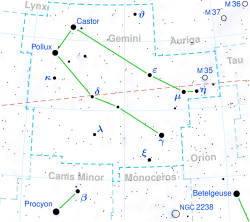Zeta Geminorum
bintang yang terletak di rasi bintang Gemini
Zeta Geminorum (ζ Gem / ζ Geminorum) adalah salah satu bintang di rasi Gemini. Bintang berada di "kaki kiri yang maju" dari Pollux (Pollux). Magnitudo tampak dari bintang ini berkisar antara 3,68 sampai 4,16,[2] dengan periode perubahannya 10,2 hari. Zeta Geminorum berada pada 1.200 tahun cahaya dari Matahari.[7] Bintang ini merupakan bintang supraraksasa.
| Data pengamatan Epos J2000 Ekuinoks J2000 | |
|---|---|
| Rasi bintang | Gemini |
| Asensio rekta | 07j 04m 06,53079d[1] |
| Deklinasi | +20° 34′ 13,0739″[1] |
| Magnitudo tampak (V) | 3,93 (3,68 sampai 4,16)[2] |
| Ciri-ciri | |
| Kelas spektrum | F7Ib sampai G3Ib[3] |
| Indeks warna U−B | +0,55[4] |
| Indeks warna B−V | 0,88[4] |
| Jenis variabel | Classical Cepheid[5] |
| Astrometri | |
| Kecepatan radial (Rv) | +6,7[6] km/s |
| Gerak diri (μ) | RA: –7,29[1] mdb/thn Dek.: –0,41[1] mdb/thn |
| Paralaks (π) | 278±018[7] mdb |
| Jarak | 1.183 ± 29(σ2) ± 85(σ) tc (363 ± 9(σ2) ± 26(σ)[8] pc) |
| Magnitudo mutlak (MV) | -3,99[9] |
| Detail | |
| Massa | 7,7 ± 0,3[10] M☉ |
| Radius | (65,24 ± 0,20) ± 4,17[11] R☉ |
| Luminositas | 2.900[12] L☉ |
| Gravitasi permukaan (log g) | 1,9[13] |
| Suhu | 5.260–5.780[3] K |
| Metalisitas [Fe/H] | 0,16[13] |
| Kecepatan rotasi (v sin i) | 19[14] km/s |
| Usia | 70 ± 25[8] megatahun |
| Penamaan lain | |
| Referensi basis data | |
| SIMBAD | data |
Etimologi sunting
Mekbuda adalah nama tradisional bintang ini. Nama ini merupakan akar kata dari bahasa Arab yang sama dengan Mebsuta (Epsilon Geminorum) yang mewakili cakar singa. Mekbuda sendiri berasal dari kalimat "cakar singa yang terlipat". Nama lainnya untuk bintang ini adalah:
| nama lain | asal bahasa | arti |
|---|---|---|
| 井宿七 / Jǐngsuqī | China | bintang ketujuh di rasi Sumur[16] |
| 井宿东扇第三星 / Jǐngsudōngshāndìsānxīng | China | bintang keempat di bagian timur rasi Sumur[17] |
Referensi sunting
- ^ a b c d van Leeuwen, F. (November 2007). "Validation of the new Hipparcos reduction". Astronomy and Astrophysics. 474 (2): 653–664. arXiv:0708.1752 . Bibcode:2007A&A...474..653V. doi:10.1051/0004-6361:20078357.
- ^ a b Klagyivik, P.; Szabados, L. (September 2009), "Observational studies of Cepheid amplitudes. I. Period-amplitude relationships for Galactic Cepheids and interrelation of amplitudes", Astronomy and Astrophysics, 504 (3): 959–972, arXiv:0908.3561 , Bibcode:2009A&A...504..959K, doi:10.1051/0004-6361/200811464
- ^ a b Kervella, P.; et al. (March 2001), "The angular diameter and distance of the Cepheid ? Geminorum", Astronomy and Astrophysics, 367 (3): 876–883, arXiv:astro-ph/0102359 , Bibcode:2001A&A...367..876K, doi:10.1051/0004-6361:20000490
- ^ a b Nicolet, B. (1978), "Photoelectric photometric Catalogue of homogeneous measurements in the UBV System", Observatory, Bibcode:1978ppch.book.....N
- ^ Samus, N. N.; Durlevich, O. V.; et al. (2009). "VizieR Online Data Catalog: General Catalogue of Variable Stars (Samus+ 2007-2013)". VizieR On-line Data Catalog: B/gcvs. Originally published in: 2009yCat....102025S. 1. Bibcode:2009yCat....102025S.
- ^ Wielen, R.; et al. (1999), "Sixth Catalogue of Fundamental Stars (FK6). Part I. Basic fundamental stars with direct solutions", Veröff. Astron. Rechen-Inst. Heidelb, Astronomisches Rechen-Institut Heidelberg, 35 (35), Bibcode:1999VeARI..35....1W
- ^ a b Benedict, G. Fritz; et al. (April 2007), "Hubble Space Telescope Fine Guidance Sensor Parallaxes of Galactic Cepheid Variable Stars: Period-Luminosity Relations", Astronomical Journal, 133 (4): 1810–1827, arXiv:astro-ph/0612465 , Bibcode:2007AJ....133.1810B, doi:10.1086/511980.
- ^ a b Majaess, D.; et al. (2012), "Discovery of the Host Cluster for the Fundamental Cepheid Calibrator Zeta Geminorum", Astrophysical Journal Letters, 748 (1): L9, arXiv:1202.2363 , Bibcode:2012ApJ...748L...9M, doi:10.1088/2041-8205/748/1/L9
- ^ Turner, D. G. (2010). "The PL calibration for Milky Way Cepheids and its implications for the distance scale". Astrophysics and Space Science. 326 (2): 219. arXiv:0912.4864 . Bibcode:2010Ap&SS.326..219T. doi:10.1007/s10509-009-0258-5.
- ^ Tetzlaff, N.; Neuhäuser, R.; Hohle, M. M. (January 2011), "A catalogue of young runaway Hipparcos stars within 3 kpc from the Sun", Monthly Notices of the Royal Astronomical Society, 410 (1): 190–200, arXiv:1007.4883 , Bibcode:2011MNRAS.410..190T, doi:10.1111/j.1365-2966.2010.17434.x
- ^ Groenewegen, M. A. T. (November 2007), "The projection factor, period-radius relation, and surface-brightness colour relation in classical cepheids", Astronomy and Astrophysics, 474 (3): 975–981, Bibcode:2007A&A...474..975G, doi:10.1051/0004-6361:20078225
- ^ Mallik, Sushma V. (December 1999), "Lithium abundance and mass", Astronomy and Astrophysics, 352: 495–507, Bibcode:1999A&A...352..495M
- ^ a b Mallik, Sushma V. (October 1998), "Chromospheric activity in cool stars and the lithium abundance", Astronomy and Astrophysics, 338: 623–636, Bibcode:1998A&A...338..623M
- ^ Uesugi, Akira; Fukuda, Ichiro (1970), "Catalogue of rotational velocities of the stars", Contributions from the Institute of Astrophysics and Kwasan Observatory, University of Kyoto, Bibcode:1970crvs.book.....U
- ^ "V* zet Gem -- Classical Cepheid (delta Cep type)", SIMBAD, Centre de Données astronomiques de Strasbourg, diakses tanggal 2012-01-01
- ^ salah satu rasi bintang menurut bangsa Cina
- ^ http://www.chinese-tools.com/tools/sinograms.html
